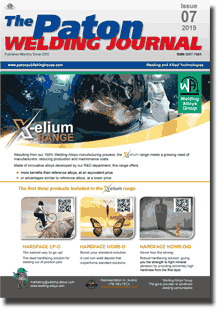| 2019 №07 (01) |
DOI of Article 10.15407/tpwj2019.07.02 |
2019 №07 (03) |

The Paton Welding Journal, 2019, #7, 7-11 pages
Journal The Paton Welding Journal
Publisher International Association «Welding»
ISSN 0957-798X (print)
Issue #7, 2019 (July)
Pages 7-11
Influence of tool shape for friction stir welding on physicomechanical properties of zones of welds of aluminium alloy EN AW 6082-T6
K. Krasnovsky1, Yu.A. Khokhlova2 and M.A. Khokhlov2
1Institute of Welding 16-18 Bl. Czeslava Str., Gliwice, 44-100, Poland. E-mail: is@is.gliwice.pl
2E.O. Paton Electric Welding Institute of the NAS of Ukraine 11 Kazimir Malevich Str., 03150, Kyiv, Ukraine. E-mail: office@paton.kiev.ua
The paper presents the results of studying the formation of macrostructure and distribution of mechanical properties in welded joints of flat specimens from aluminium alloy EN AW 6082-T6 of 8 mm thick, produced by the method of friction stir welding with application of three types of specially designed pins with collars: C — cylindrical threaded pin and collar with a spiral groove; T—cylindrical threaded pin with three grooves and collar with a spiral groove; S — smooth cylindrical pin without thread and flat collar. Friction stir welding was performed in the equipment of the Institute of Welding in Gliwice (Poland), and treatment and mechanical tests were conducted at the E.O. Paton Electric Welding Institute of the NAS of Ukraine. Mechanical testing by indentation was performed in Micron-gamma device, which allows experimental identification of structural state of metal after refinement and determination of the strain hardening presence by limiting values of ratio of hardness to Young’s modulus of elasticity. It was found that for all three specimens the HAZ hardness decreases, and in the zone of thermomechanical effect the hardness increases. Maximum hardness values are inherent to the central part of welded joint nugget, as well as to light-coloured oval concentrated fragments of structure in the nugget upper and lower part. Judging by the presence of nanosized hardened structure and uniformity of its distribution in the nugget, as well as good dispersion of oxide films and absence of discontinuities, the friction stir welding with C-type tool can be regarded as the optimum variant. An assumption was made that formation of a uniform structure in welds can be achieved at three-four rotations of the tool in friction stir welding in one place. 21 Ref., 1 Table, 7 Figures.
Keywords: friction stir welding, zone of thermomechanical effect, weld nugget, indentation, Berkovich indenter, Young’s modulus, physicomechanical properties
Received: 06.03.19
Published: 24.07.19
References
1. Thomas, W.M., Nicholas, E.D., Needham, J.C. et al. (1991) Friction stir butt welding. European Patent Specification 06 15 480 B1.2. Dawes, C.J. (1995) An introduction of friction stir welding and its development. Welding & Metal Fabrication, 63, 13-16.
3. Mishra, R.S., Ma, Z.Y. (2005) Friction Stir Welding and Processing. Mater. Sci. Eng., 50A, 1-78. https://doi.org/10.1016/j.mser.2005.07.001
4. Uday, M.B., Ahmad Fauzi, M.N., Zuhailawati, H., Ismail, A.B. (2010) Advances in friction welding process: A Review. Sci. Technol. Weld. Join., 15, 534-558. https://doi.org/10.1179/136217110X12785889550064
5. Krasnowski, K., Sędek, P., Łomozik, M., Pietras, A. (2011) Impact of selected FSW parameters on mechanical properties of 6082-T6 aluminium alloy butt joints. Archives of Metallurgy and Materials, 56, 4, 965-973. https://doi.org/10.2478/v10172-011-0106-9
6. Threagill, P.L., Leonard, A.J., Shercliff, H.R., Withers, P.J. (2009) Friction stir welding of aluminium alloys. Int. Mater. Rev., 54(2), 49-93. https://doi.org/10.1179/174328009X411136
7. Nandan, R., DebRoy, T., Bhadeshia, H.K.D.H. (2008) Recent advances in friction-stir welding: process, weldment structure and properties. Prog. Mater Sci., 53, 980-1023. https://doi.org/10.1016/j.pmatsci.2008.05.001
8. Krasnowski, K., Dymek, S. (2013) A comparative analysis of the impact of tool design to fatigue behavior of single-sided and double-sided welded butt joints of EN AW 6082-T6 Alloy. J. of Mater. Eng. and Performance, 22(12), 3818-3824. https://doi.org/10.1007/s11665-013-0711-z
9. Krasnowski, K. (2014) Fatigue and static properties of friction stir welded aluminium alloy 6082 lap joints using Triflute-type and smooth tool. Archives of Metallurgy and Materials, 59(1), 157-162. https://doi.org/10.2478/amm-2014-0025
10. Kalemba, I., Kopyscianski, M., Dymek, S. (2010) Investigation of friction stir welded Al-Zn-Mg-Cu aluminum alloys. Steel Research Int., 81(9), 1088-1096.
11. Mustafa, B., Adem, K. (2004) The influence of stirrer geometry on bonding and mechanical properties in friction stir welding process. Materials and Design, 25, 343-347. https://doi.org/10.1016/j.matdes.2003.11.005
12. Standard DIN EN 573-3:2009: Aluminium and aluminium alloys. Pt 3: Chemical composition and form of wrought products. Chemical composition and form of products.
13. Oliver, W.C., Pharr, G.M. (1992) An improved technique for determining the hardness and elastic modulus using load displacement sensing indentation experiments. J. Mater. Res., 7, 1564-1583. https://doi.org/10.1557/JMR.1992.1564
14. Oliver, W.C., Pharr, G.M. (2004) Measurement of hardness and elastic modulus by instrumented indentation: Advances in understanding and refinements to methodology. Ibid., 19(1), 3-21. https://doi.org/10.1557/jmr.2004.19.1.3
15. Khokhlova, Yu.A., Klochkov, I.N., Grinyuk, A.A., Khokhlov, M.A. (2009) Verification of Young's modulus determination using «Micron-gamma» microprobe system. Tekh. Diagnost. i Nerazrush. Kontrol, 1, 30-32 [in Russian].
16. Khokhlova, Yu.A., Ishchenko, D.A., Khokhlov, M.A. (2017) Indentation from macro- to nanometer level and examples of investigation of properties of materials with a special structure. Ibid., 1, 30-36 [in Russian]. https://doi.org/10.15407/tdnk2017.01.05
17. Nano indenters from micro star technologies. Revision 2.3. http://www.microstartech.com
18. Kazuhisa Miyoshi (2002) Surface characterization techniques: An Overview NASA/TM-2002-211497, 12-22.
19. Doener, M.F., Nix, W.D. (1986) Indentation problems. J. Mater. Res., 1, 601-614. https://doi.org/10.1557/JMR.1986.0601
20. Gorban, V.F., Mameka, N.A., Pechkovsky, E.P., Firstov, S.A. (2007) Identification of structural state of materials by automatic indentation method. In: Proc. of Kharkov Nanotechnological Assembly (Ukraine, Kharkov, 23-27 April 2007). Ed. by I.M. Neklyudov et al. Vol. 1: Nanostructural materials, 52-55 [in Russian].
21. Firstov, S.A., Gorban, V.F., Pechkovsky, E.P., Mameka, N.A. (2007) Relationship of strength characteristic with indexes of automatic indentation. Materialovedenie, 11, 26-31 [in Russian].
